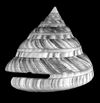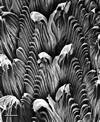| |
|||
|
| |||
|
Carole Hickman’s research focuses on what she calls the “pattern problem.” She strives to understand how the building blocks of life come together to produce distinctive structural patterns, and thinks about how these patterns are grown—starting with a single cell even in very complex multicellular organisms—and how they change and evolve. This is a critical question in biology and paleontology, since scientists study the relationships among organisms. Hickman notes that two organisms might share a very similar pattern or structural design for one of three reasons. Perhaps the patterns evolved separately, but they are similar because the patterns fulfill a common function (as with the wings of birds and bats). In other cases, organisms share a particular structural design due to their evolutionary history. The forelimbs of humans and horses, for example, function very differently but have similar structure because of their common ancestry. And the physical rules of how organisms grow may also dictate certain similarities, since the basic building blocks can be assembled in a limited number of ways. In Hickman’s opinion, “The problem of structure and pattern is the most important problem in all of biology and paleontology.” She studies all aspects of this “pattern problem”—structure, function, development, and even patterns found in the non-living world. |
Click on images for enlarged views.
|
An unrepentent “morphologist” “I went through a phase where I felt like people were trying to get me to say that I was a ‘functional morphologist,’ an ‘evolutionary morphologist,’ or a ‘developmental morphologist,’” recalls Hickman. “I told people, I’m not going to put anything in front of ‘morphologist’ because I don’t want to say that I’m only interested in function, structure, or evolution.” Why snails? Her interest in snails also has some basis in aesthetics: “As humans, we are attracted to things that have a degree of order to them, and also to things that are complicated. In terms of trying to understand pattern, I’m attracted to things that are also aesthetically pleasing.” |
|
| Browse the Profile: Profile | Research | Techniques | On Science | |||
| Home | What’s new | About UCMP | History of life | Fossil collections | Other resources | |||


